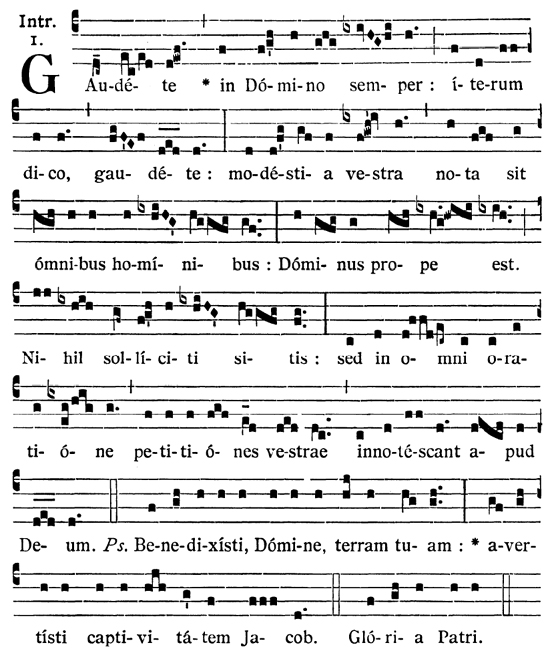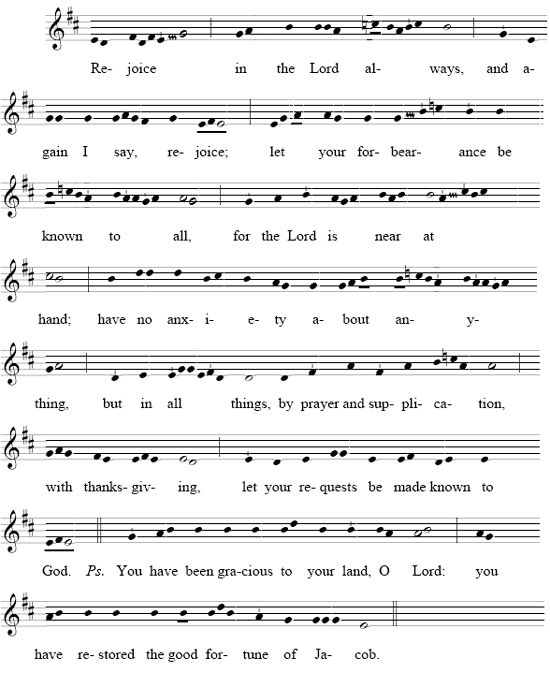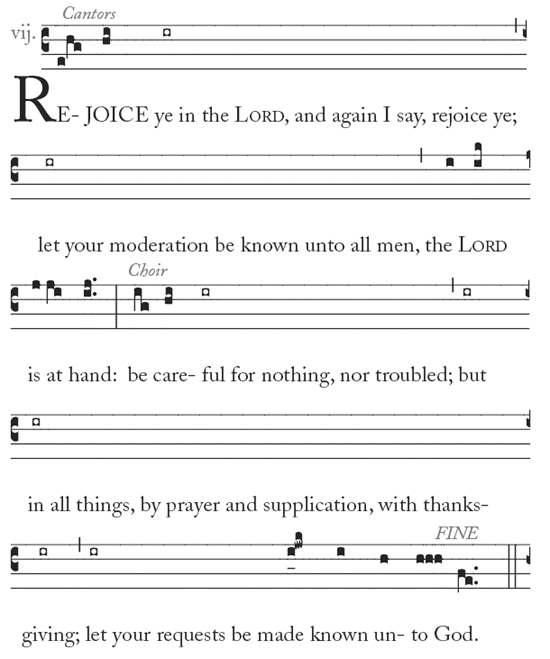-
For Gaudete Sunday.
(added at later date)
After researching this piece, it seems it is utilized as a Christmas carol, and not as a hymn during Advent. -
Thank you for posting it. Very beautiful and easy to learn.
-
Here is a sound file on the internet in typical ren form.
http://www.musiceducationworld.com/files/11_-_Gaudete-_Brighton_Choir_Dir._Michael_Griffin.mp3 -
Perhaps more appropriate for the Christmas season than for Advent? The "Gaudete" of third Sunday is taken from the Introit, which goes on to say "Domine prope est" (the Lord is near). This is a nice arrangement, though, of a tune that is always a hit.
-
Well, I am no theologian or liturgical scholar, and yes, technically the text is more Christmas, but Gaudete Sunday gives us a glimpse of Christmas, thus why the differentiating Rose vestments. We all know the Introit for the Third Sunday is "Gaudete in Domino" and the text is entirely different. You will have to check with the liturgists if you want to truly know if it is appropriate for Gaudete, otherwise, you can certainly sing it confidently for Christmas.
-
It has occurerd to me that it would very interesting to know the historical development of Gaudete Sunday, how it came to be and what theological and traditional practices may have been covered over in the last century (as so many of our rich and beautiful traditions have been stolen away.) The main obvious element is that it shares a tie with Laetare Sunday in that both utilize rose colored vestments as a sign of the anticipation of the two mysteries of the Nativity and the Ressurrection. Does anyone have any more details?
Here is a start, though I am suspect of wiki, nevertheless, here it is.
http://en.wikipedia.org/wiki/Laetare_Sunday
http://en.wikipedia.org/wiki/Gaudete_Sunday -
Dear Francis,
Why the verse melody that seems to shift modes? -
Not sure who composed this... but it is very interesting, don't you think? Changing modes during the same piece is a common compositional tool used to create an effect. In this case the verses shift a perfect fourth down (into Emin) the verses sounding on the dominant (minor) key of the antiphon giving it a lifting effect each time one returns to the antiphon itself. One experiences the toggle between Aminor and Eminor throughout the work. Perhaps that creates the sense of 'anticipation'.
If you are interested to hear many variations of this piece just do a 'gaudete' on youtube. While the antiphon is very consistent in melody and harmonic structure, the verses are widely varried in their treatment. Never let anyone stuff you into a pigeonhole on the 'proper' performance of a composer's work... we composers like to change our own works all the time! I have 20 versions of a particular Mass I composed and 'recomposed' over and over during a 10 year span of time.
Has anyone any more information on appropriateness of this text? I was thinking of programming it for Gaudete Sunday, but not sure if it would be liturgically correct (as brought up earlier in this thread). Is there any help out there!? -
As far as information. no. To me it sounds like a text for Christmas day, not Gaudete Sunday. "Christ is born," and so forth. The introit proper says "Dominus prope est" (the Lord is near). The traditional emphasis seems to be on the imperative Veni!
.02 -
Thnx, Pes. Yes, I am aware of the introit for that day.
Here is some more info on the piece that reveals that music was not originally composed for the verse. Hence the variations found.
http://en.wikipedia.org/wiki/Gaudete
Originally in this collection:
http://en.wikipedia.org/wiki/Piae_Cantiones
It seems that it would be more appropriate for Christmas. -
Hope this is useful to someone. Observe:
From the Graduale Romanum, we have the Gregorian proper:
From The American Gradual we have this excellent English version in adapted modern notation:
Or from the Psalm-tone Gradual, we have this reduced version that any parish can use:
-
Don't forget the NOH organ accompaniment to Gaudete Introit! ;-)
Also, does anyone else agree that in the Psalm tone, they probably should have divided it differently?
how do I describe what I mean? ---- they should have used the tone twice, instead of making it so long -
I'm looking forward to singing the Graduale Romanum version on Gaudete Sunday. But yes, Jeff O is right--this is so long it could easily and more gracefully use the psalm tone formula twice.
Seeing that English text reminds me there's a very accessible four-part Tudor anthem to this text by that famous composer Anonymous. I'm thinking it's in the Oxford Easy Anthem Book, or a similar collection. That version probably wouldn't do as an Introit, but might be more useful as, say, an Offertory anthem. -
Here is my contribution, revisited and revised from a collection of Trio Introits (of modest to lesser success) that I knocked out a few years back, covering most of the Church year. It might be useful for choirs of all treble voices, though the lowest part is probably best carried by a tenor or two. (Write if you want a midi recording; I can't seem to post it here.)
-
Ok, this Guadete by RR is wonderful. I just left a planning session in which we have decided to use this instead of an English tone setting - the Gregorian one couldn't be put into the schedule. so this is a done deal. Very exciting. It's wonderful. Thank you RR!
-
RR, email Aris about the midi. I think it's always good to have the audio.
By the way, regarding the Greg proper, you can suggest a major sound by implication if you lengthen the duration of the last pitch on "gaudete" (fa) and sharpen it ever so slightly. You can thereby imply a shift to F major, which the next phrase clearly conveys.
I know the terms are anachronistic, but you get the idea. -
\"RR, email Aris about the midi.\"
Who is this, then? -
Oh, that's Aristotle Esguerra, the forum webmaster: aristotle@esguerra.info
-
Jeff O-
I agree that the psalm tone seems rather...elongated. However, (since you've already mentioned organ accompaniment!) if you change the chord (or whatever it's called in the world of modal accompaniment...) several times underneath the same melody note, it makes it less noticeable, easier to sing, and it sounds great on the same note for that length of time! -
I've posted an MP3 version of my trio Introit, Gaudete, here:
http://mysite.verizon.net/res1177m8/id3.html
Please judge it gently. -
Here is Dom Johner on the Introit, in a mostly practical mood:
What an attentive singer he must have been. His whole book is musical lectio divina. I'll post a thread on the Gradual for this day, which bears serious attention.The first phrase may be taken as a model of phrase structure in chant: an ascent from the tonic to the dominant, a halting on the dominant, then a descent to the tonic. Each of its members moves within a different tetrachord: c > f, f > b-flat, d > g. The continuous growth of the melody in the first half of the verse portrays gradations of feeling: Rejoice; then more: Rejoice in the Lord; then still more: Rejoice at all times. Here a crescendo is obviously demanded. What follows is somewhat surprising. Where we would sing iterum dico quietly, to give that feeling of expectation, and then gaudete very emphatically, choral by its simple return to the tonic tells us: Let your Christmas joy be interior, heartfelt!
The ancients called for ascensiones pudicas in the melodic line: a modest, chaste rising upward. This is satisfied in the second phrase. There is some resemblance to Domino semper; but here the melody does not reach high b-flat by means of a third, but with ascending seconds. The prolongation of the dominant a over omnibus ho-(minibus) and the extension of / over petitiones in the fourth phrase, according to some, portray the immense multitude of men, or perhaps their petitions. Then, all aglow with light, comes Dominus prope est. A hidden urge must characterize the three porrectus; a note of joyful victory should resound in Nihil solliciti sitis. Here we find practically the same cadence as over (ho)-minibus.
Solemnity and impressiveness should mark the last phrase. Its low pitch and its emphasis on the dominant / puts it in marked contrast to the preceding. Oratione alone seems to indicate that prayer is a lifting of the entire being to God. Sed in omni and innotescant are similar. The pressus over omni effectively accents the thought that our prayer must be fervent. In free translation one might expand this to: everything in our lives should be transformed into prayer.
The psalm-verse stands out prominently, especially because several times it extends to high c, while the antiphon never went above b-flat.
Welcome to the MusicaSacra Forum!
To participate in the discussions on Catholic church music, sign in or register as a forum member, The forum is a project of the Church Music Association of America.
Categories
- All Discussions21,169
- General Music Discussion8,244
- Job Openings204
- Management of Music Programs851
- Choral Matters534
- Church Documents and Rubrics526
- CMAA Notes304
- Events720
- For Newcomers: Read First26
- Sacred Polyphony547
- Hymnody872
- Gregorian Chant: General2,703
- ↳ Graduale Romanum and Liber Usualis369
- ↳ Graduale Simplex60
- ↳ Semiology63
- Vernacular Plainsong696
- Anglican Use and Anglican Chant68
- Organ, Other Instruments and Repertoire435
- New Composition/Works in Progress1,295
- Recordings234
- Music for Hispanic Ministry159
- Music Education: Children211
- Music Education: General222
- News Items245
- Positions Wanted2
- General Discussion: Catholicism740
- Amusements177
- General Discussion1,035
- Opinions119



